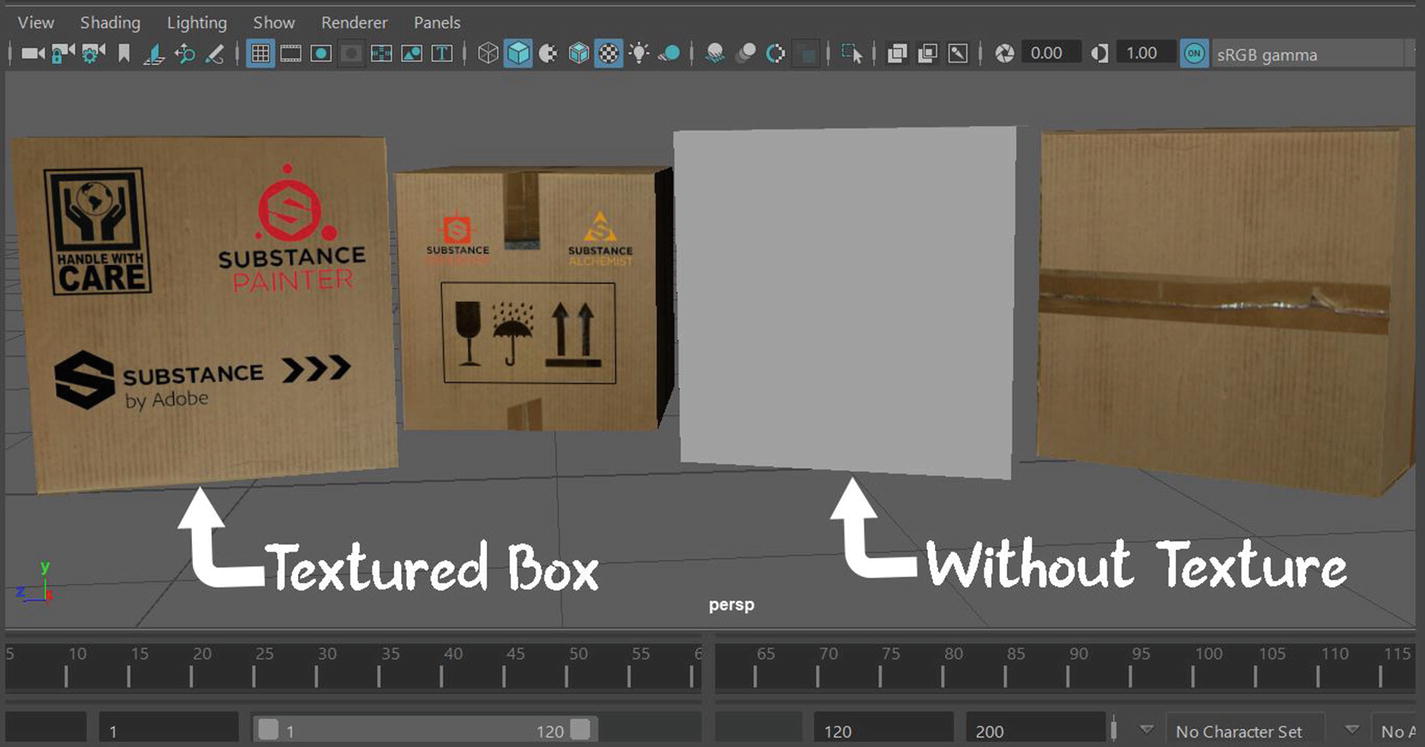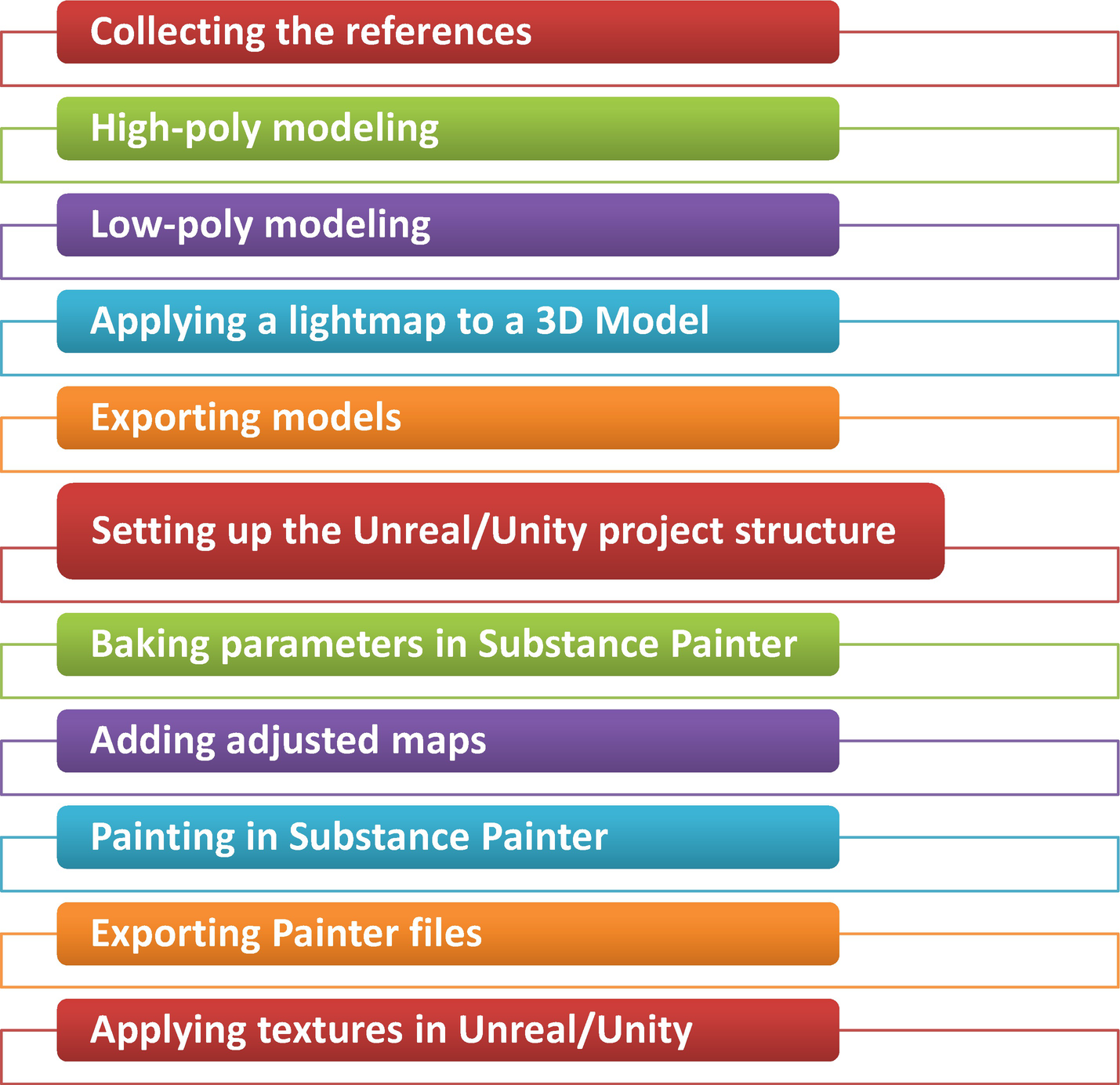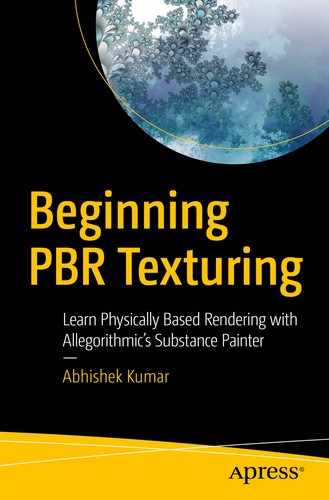The 3D painting workflow for texturing has become popular because it is intuitive and easy to understand when you are painting your materials. To use it, you’ll need several types of texture maps that together make up a material. And with different types of texture maps come different types of texturing workflows. What we are going to focus on in this book is PBR texturing and two of its main types: the metallic-roughness workflow and the specular-glossiness workflow. But before we dive deep into these topics, I’ll talk about how texturing works.

Texturing workflow

Texturing workflow result
Game Texturing Pipeline
Let’s take a look at the process of creating a game asset. There are 11 steps to creating an entire game asset, as shown in Figure 3-3. Although our main focus is the texturing part here, in later chapters, we will cover everything from step 4 onward.

Game asset creation pipeline
Useful Tips for Texture Artists
References study: Before starting the texturing, the artist should study the physical properties of textures from real-life examples and specifically look at how light hits the surface of the model.
Your own library: Whenever you are traveling around the globe and find anything interesting, capture the images and save them in your own library. These can be photographs anything such as wood, bricks, fur, clouds, cloth, tiles, etc. Later, with the help of the Photoshop software, you can tweak the images and use the texture for further enhancements.

Examples of available 3D material and texture libraries
What Is UV Mapping?

UV unwrapping
Types of Textures
Texture refers to the immediate tangible feel of a surface and the visual impression of simple stimuli such as color, orientation, and intensity in an image.
Diffuse map
Albedo map
Transparency/alpha map
Specular map
Bump map
Normal map
Displacement map
Ambient occlusion map
Diffuse: Diffuse maps represent the overall color of the model; this is the most common type of texture. A bitmap image, captured from a camera, painted, or scanned, can be used as a diffuse map to portray the photorealistic quality of a 3D object. Diffuse has the information of light and shadow.
Albedo: An albedo map is similar to a diffuse map. It has had all the lighting and shadow information removed from it and is literally the color values of the image.
Opacity or transparency: A transparency map depends upon the gray values of an image. Usually the black parts will be opaque, and the white parts will be visible.
Specular: A specular map defines the shininess of the surface at a certain position.
Bump: A bump map is used to create the relief on the surface. We can use a bump map to generate the illusion of depth on the surface of the 3D model. A bump map is generally used to generate virtual scratches, cracks, tiny surface details, etc. The virtual depth depends upon the camera angle. When the value is close to white, the result looks like it is protruding out of the surface, and black tends to push it into the surface. It’s not vertex dependent.
Normal: This type of map is used to project high-resolution model details on a low-resolution model. On the basis of chorochromatic map, a normal map texture changes the normal of a pixel.
Displacement: A displacement map is vertex dependent. This map generates physical depth based on the grayscale value of the map.
Ambient occlusion: An ambient occlusion map is used to generate the shadows or darkness caused by the closeness of objects.

Examples of a variety of maps for game texturing
A few more types of maps are useful for creating the best results in game production pipelines such as ID maps, parallax maps, glossiness maps, vector displacements, height maps, fuzz maps, roughness maps, cavity maps, curvature maps, translucency or thickness maps, etc.
Now you know about the maps, so what maps are most important and commonly used in production? If you using a PBR metallic-roughness workflow, then you will need the albedo, metallic, roughness, normal, and ambient occlusion maps. For a PBR specular-glossiness workflow, you will need the diffuse, specular, glossiness, normal, and ambient occlusion maps. Which workflow you use depends on your engine of choice. The Unity game engine uses the specular-glossiness workflow, while Unreal Engine 4 uses the metallic-roughness workflow. In the next chapter, you will see how texturing works in movies and in games and how they are different from each other.
